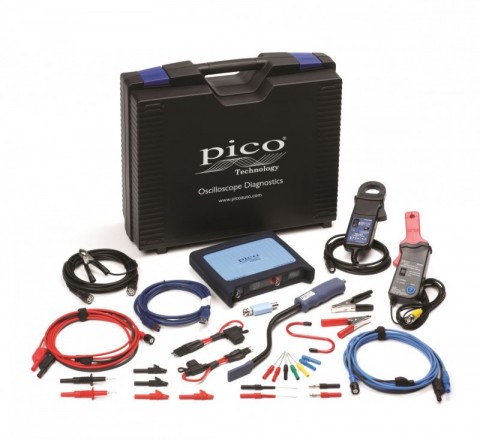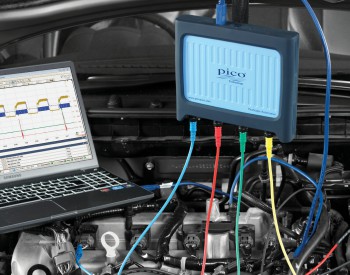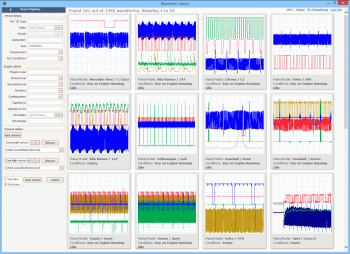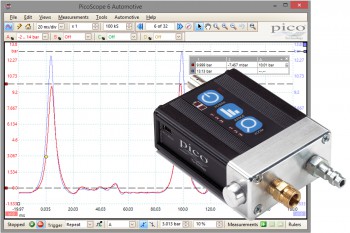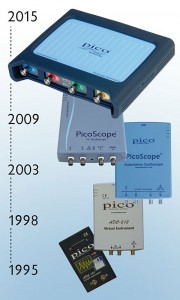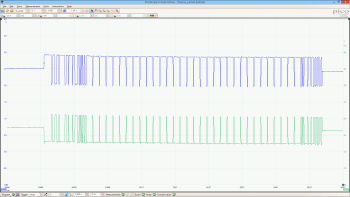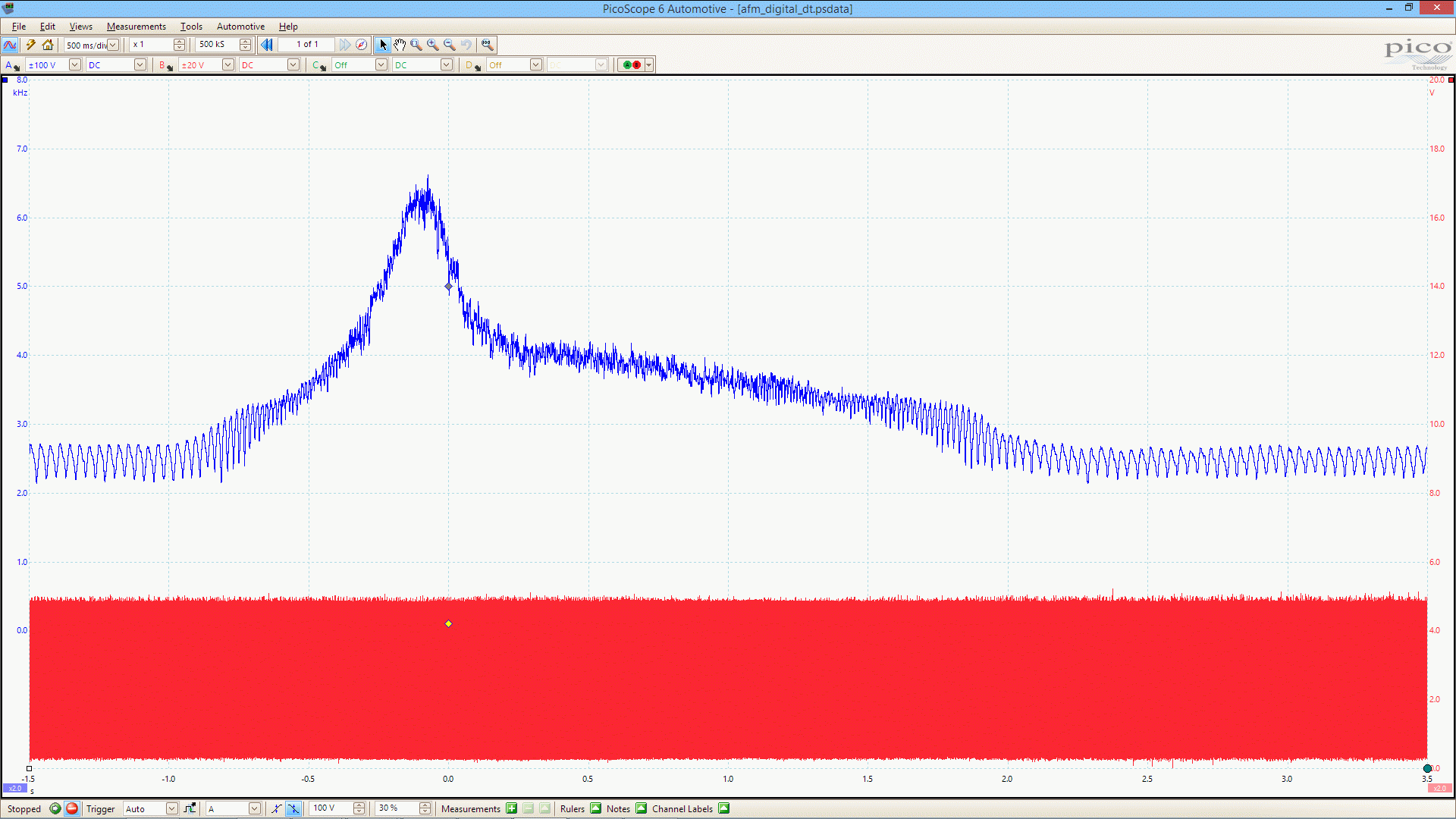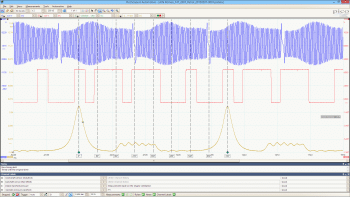
The Pico Automotive Diagnostics Kits work with your PC to measure and test virtually all of the electrical and electronic components and circuits in any modern vehicle including
PicoScope oscilloscope kits
 The Pico Automotive Diagnostics Kits work with your PC to measure and test virtually all of the electrical and electronic components and circuits in any modern vehicle including:
The Pico Automotive Diagnostics Kits work with your PC to measure and test virtually all of the electrical and electronic components and circuits in any modern vehicle including:
- Ignition (primary and secondary)
- Injectors and fuel pumps
- Starter and charging circuits
- Batteries, alternators and starter motors
- Lambda, airflow, ABS and MAP sensors
- Electronic throttle control
- CAN bus, LIN bus and FlexRay
Find out why PicoScope is like no other oscilloscope with features and benefits that make it the world’s leading choice for vehicle manufacturers and aftermarket garages alike.

Scan tool or scope?
We are often asked “Should I buy a scan tool or a scope”. The short answer is that you need both. A scan tool can often point you in the right direction, perhaps indicating a misfire on a specific cylinder but too often the less experienced technician then ends replacing several parts before the problem is solved. Oscilloscopes should be used:
- To eliminate guesswork and test individual components before they are replaced. This avoids “parts darts” where more and more parts are replaced until the fault goes away.
- To find intermittent wiring and connector faults.
- When a vehicle has a problem but no code has been set or when multiple / misleading codes have been set
- As the best way to find charging and starting problems.
- To find problems with actuators such as motors and injectors that are not monitored by the ECU.
- To identify mechanical problems such as compression and slipped / incorrectly fitted timing belts.
For the technician oscilloscopes lead to faster, more efficient diagnostics and a better understanding of how vehicle systems work. For the workshop using a PicoScope encourages a “fix it right” culture by reducing the number of parts changed on guesswork. The net result is improved customer satisfaction, increased repeat business and increased profits.
Open your eyes with PicoScope software
PicoScope 6 is the most advanced automotive oscilloscope software available to date. With award-winning features and intuitive design, this software is designed to make sure you get to the heart of the problem, fast.
Features such as auto setup, tutorials and the guided tests quickly get new users up to speed. Advanced features such as maths channels, waveform buffers, advanced triggers and reference waveforms ensure the experienced user will not run out of power.
The modern user interface is easy to use. There are no old-fashioned knobs and dials. We leave the space free for what matters: your waveforms displayed in crisp, clear high resolution.
PicoScope software has now firmly established itself as the industry standard so the time you invest in improving your diagnostic skills will benefit you for the rest of your career. Regular updates to our software include new features and new tests, and are free for the life of the product.
More information on the PicoScope software >>
PicoScope: future-proof
The recently introduced two-channel PicoScope 4225 and four-channel PicoScope 4425 are our 5th generation of automotive PC oscilloscopes. They are 5x faster and have 8x more memory than the previous generation, ensuring they are powerful enough for the next generation of vehicles with new technologies such as CAN FD.
Other innovations include new floating inputs for non-grounded measurements, higher input ranges and ConnectDetect to ensure you have a good connection. The new PicoScopes are also now USB 3.0 connected and powered.
When you purchase any diagnostic tool you not only spend money but you also spend time learning how best to use it. We protect that investment in two ways. First, we develop hardware and software that is easy to use for those starting out with oscilloscopes yet has the power and features demanded by experienced users. Second, we do not compromise on quality or specifications – expect the PicoScope you buy today to still be an essential part of your diagnostic tool box 10 years from now.
More information on the PicoScope hardware >>
PicoScope guided tests
Built into the software are over 150 guided tests ranging from simple injector tests through to more complex topics such as CAN bus testing.
When you select a guided test all settings are configured for you and an example waveform is loaded. Diagrams and photos then show you which leads and accessories you need, how to connect to the vehicle and perform the test.
Once the test has been completed there is guidance on understanding the waveform, how the component works and typical faults / fixes.
As vehicle technology changes we continue to add more tests through free software updates.
More information on the guided tests >>
Cam vs crank waveforms from the library
Waveform library
The library enables you to share and back up your waveforms online and also search a global database of waveforms uploaded by PicoScope users from around the world.
The powerful search options let you find “known good” waveforms from vehicles identical to the one you are working on. Not sure if you have a slipped timing belt? There are hundreds of cam vs crank waveforms to compare against. Not sure if the cranking current is too high? Download a waveform to compare.
More information on the Waveform library >>
PicoDiagnostics
With a simple connection to the battery, PicoDiagnostics software quickly performs the following tests:
- Compression test. Crank the engine to quickly display the relative compression of each cylinder.
- Cylinder balance / misfire detect. Compares the power output of each cylinder and highlights misfires.
- Battery test. Displays CCA, measures state of charge and voltage drop during starting. Gives an overall Pass / Fail.
- Starter motor test. Checks starter coil resistance and voltage drop across cables.
- Alternator test. Measures charging voltage and current. Checks for excessive diode ripple.
More information on PicoDiagnostics >>
WPS500X pressure sensor kit (optional)
Adding the WPS500X to your PicoScope opens up a new world of diagnostics by turning pressure readings into waveforms. In-cylinder waveforms show valve and timing issues, mechanical failures, blown gaskets and blocked catalytic converters.
Most pressure sensors can only measure over a limited range (so you need different ones for different tasks). The WPS500X has three ranges in one sensor so it is flexible enough to work right around the vehicle – fuel pressure, transmission pressure, intake vacuum and even pulses from the exhaust.
Supplied as a complete kit with hoses (compression, fuel, vacuum, bleed) and adaptors (exhaust, M10/M12/M14 plugs and universal).
More information on the WPS500X pressure sensor >>
Noise and vibration kit (optional)
Improvements in damping and sound insulation in modern vehicles mean that vibrations and noise that would previously be ignored (by turning up the radio) are now diagnostic headaches. Many hours can be spent and parts swapped in tracking down customer complaints.
The NVH kit works with your PicoScope to quickly identify the source of the problem. If the customer complaint is noise, use the microphone; if it’s a vibration, use the accelerometer. Sophisticated software quickly pinpoints the source of the problem.
The kit can be enhanced with accessories to also allow on-vehicle driveline balancing.
More information on the NVH kit >>
Getting started – help all the way
Many technicians know that they should be using oscilloscopes but are worried they will be too difficult to use. If you are confident using multimeters and scan tools, you will have no problem learning to use a PicoScope.
The manual guides you step by step through installing the PicoScope and making your first measurement of battery voltage and from there the guided tests take over, showing you how to test the common components on vehicles. Next we offer a huge range of free resources to help you get the most out of your PicoScope including online training, videos and case studies. There is also a great community of users who share knowledge, waveforms and advice as well as helping us by suggesting software improvements.
Many of our customers tell us how owning a PicoScope has helped them understand how a modern vehicle really works and over time has opened new career opportunities as they become respected experts in diagnostics.
Buying a PicoScope is unlike dealing with some other companies who lose interest as soon as they have your money. At Pico we stand behind our products and offer free lifetime technical support by phone and online. Software updates are also free – your PicoScope keeps getting better with no subscriptions or ongoing fees to pay. It is no surprise that PicoScopes are chosen by more vehicle manufacturers and aftermarket customers than any other oscilloscope.
PicoScope oscilloscopes – future-proof
Pico have been designing, manufacturing and improving our oscilloscopes for over 20 years. Our objective is simple: to make the best automotive oscilloscope in the world.
The recently introduced two-channel PicoScope 4225 and four-channel PicoScope 4425 are our 5th generation of automotive PC oscilloscopes. They are 5x faster and have 8x more memory than the previous generation, ensuring they are powerful enough for the next generation of vehicles with new technologies such as CAN FD.
Other innovations include:
- New floating inputs for non-grounded measurements and voltage drop tests
- Higher voltage ranges (up to 200 V without attenuators)
- ConnectDetect® to ensure you have a good connection
- Advanced triggers to capture intermittent faults
- Hardware filters and frequency measurement
- USB 3.0 connected and powered.
When you purchase any diagnostic tool you not only spend money but you also spend time learning how best to use it. We protect that investment in two ways. First we develop hardware and software that is easy to use for those starting out with oscilloscopes yet has the power and features demanded by experienced users. Second, we do not compromise on quality or specifications, so expect the PicoScope you buy today to still be an essential part of your diagnostic toolbox 10 years from now.
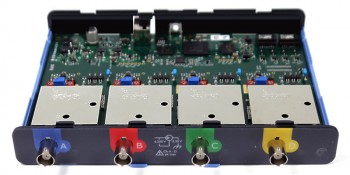
Floating inputs
Floating input channels are a unique new technology that allows safe, low-noise measurements even in situations where none of the inputs are grounded.
Floating inputs allow a single input to perform voltage drop tests (for example, along the battery to starter motor cable) and measurements on non-grounded signals like hybrid electric motor drives. With floating inputs the maximum allowable voltage difference between any two channel grounds is 30 V.
The inputs can now measure up to 200 V (up from 100 V on the previous generation of PicoScope). A key benefit is that external attenuators are no longer needed for measuring injector voltages.
Remember: on a floating-input scope, grounding one input does not ground all the others. You must provide signal and return connections for each input that you are using.
ConnectDetect®
Ensuring that you have a good connection to the signal you want to test is not always easy. With ConnectDetect enabled, indicators on screen and lights on the scope itself turn from red to green as soon as a good connection is detected.
Once a good connection is established the on-screen icons fade so as not to obscure the waveform. If, however, the status changes (for example vibration causes a probe to become loose) then the icons will highlight the change.
Memory buffer
Often the best way of diagnosing an intermittent fault is to set up the scope to measure from several components and wait for the fault to occur. For an intermittent misfire you might want to capture several minutes of cam, crank, ignition and injector waveforms. Such tests require an oscilloscope with a “deep” memory buffer so that you can capture for long time periods and then zoom in without gaps or loss of detail.
With a PicoScope you can collect 250 MILLION samples, more than any other automotive oscilloscope. Our advanced “always on” memory technology uses hardware acceleration to ensure processing the large amounts of data does not slow the oscilloscope down even when using a slower or older PC.
Deep memory allows long recordings at high speed – you capture a complete test drive whilst looking for intermittent faults. When not using the full memory for a single waveform, PicoScope automatically stores up to the last 10,000 waveforms in the buffer so you can stop the scope and “wind back time” to see every capture.
Crisp, clear high-resolution display
A deep waveform memory gives you a high time resolution, but a high vertical resolution is equally important. It allows you to see small changes in signal such as ignition coil oscillations and the small dip in current when an injector opens.
Many oscilloscopes only offer 8-bit resolution which allows 256 vertical steps. As most PC monitors have vertical resolutions of over 1000 pixels, this results in a low-resolution “blocky” display. The PicoScope 4225 and 4425 have 12-bit resolution (4096 steps), and when not using the full sampling rate of the scope this can be enhanced to 16 bits (65 536 steps).
The image shows the same ignition signal captured at both 8 bits and 12 bits. With the 8-bit oscilloscope the coil oscillations are distorted while at 12 bits they are in clear high definition.
Fast sampling
The latest PicoScopes can capture signals faster than ever. With sampling rates of up to 400 million samples per second, there is nothing that can escape the scrutiny of PicoScope.
CAN and FlexRay are now common on vehicles, and new protocols such as SENT for digital sensors and CAN FD (up to 5x faster than the current CAN standard) will appear in new vehicles from 2017. The fast sampling rate ensures that the PicoScope 4225 and 4425 have the speed to handle future needs as vehicle technology changes.

USB 3.0 for power, speed and simplicity
As with our previous generations of PicoScope oscilloscopes, no external power supply is required and there are no batteries to go flat, just a simple reliable connection to the USB port.
The PicoScope 4225 and 4425 have the latest SuperSpeed USB 3.0 port to interface to your PC. Don’t worry if your PC only has USB 2.0 ports – the PicoScopes are fully compatible with these too. If you have USB 3.0 on your PC you will notice slightly faster screen update rates, faster file saving and USB streaming. As more of our customers move to PCs with USB 3.0, free software updates will ensure that you get the full benefits available from the new standard.
Our unique fast USB streaming allows continuous gap-free data to be collected straight to PC memory. This makes features like our cylinder balance, battery test and (optional) NVH tests possible. It also allows the oscilloscope to display live, real-time data without waiting for the screen to refresh.
Digital Mass Air Flow (MAF) sensor
Advanced features
Most new users start by using the guided tests to configure all the settings automatically. As your experience grows there are many advanced features to explore. These include:
- Advanced digital triggers. Unique among automotive oscilloscopes, these trigger modes allow you to trigger when there is too long a time gap (such as when an injector fails to fire). They can also be set to trigger and sound an alarm when a sensor signal goes out of range.
- Filters. Some signals are noisy as wires in the loom pick up noise from other wires. The ECU filters this noise out. The PicoScope 4225 and 4425 have selectable hardware filters to remove this noise, so you see what the ECU sees.
- Hardware frequency measurement. Flow sensors and some airflow sensors output a digital frequency signal. Most oscilloscopes can’t extract usable diagnostic information from this, but your PicoScope can convert it to a conventional analog waveform (as shown in this MAF sensor example).
Every aspect of your PicoScope has been designed for a long working life, and it has the performance to ensure it will not be obsoleted by the changing technology in new vehicles. The hardware is robust and reliable with no moving parts or batteries to fail. Combine this with free support and free software updates for the life of the product and its easy to see why a PicoScope is the choice for professional diagnostics.
PicoScope software
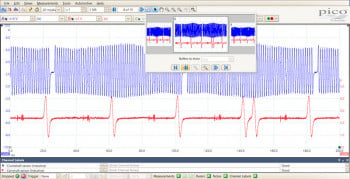 PicoScope Automotive is the powerful software package that turns your PC into a diagnostic oscilloscope when used with a PicoScope device. PicoScope has been designed to make it easy for you to diagnose vehicle faults. Packed with features such as automated measurements, reference waveforms and the ability to save and print waveforms, PicoScope Automotive is the ultimate tool for your diagnostic toolbox.
PicoScope Automotive is the powerful software package that turns your PC into a diagnostic oscilloscope when used with a PicoScope device. PicoScope has been designed to make it easy for you to diagnose vehicle faults. Packed with features such as automated measurements, reference waveforms and the ability to save and print waveforms, PicoScope Automotive is the ultimate tool for your diagnostic toolbox.
Also included is PicoDiagnostics software to quickly test batteries, alternators, starter motors, compression and cylinder balance. Professional reports allow you to show your customer what you have checked and any problems you have found.
Download the software today, which will run in demo mode without a scope attached, allowing you to explore the capability and see how PicoScope can benefit your business and customers.
Regular updates to our software include new features and new tests, and are free for the life of the product.
PicoScope guided tests
Built into the software are over 150 guided tests ranging from simple injector tests through to more complex topics such as CAN bus testing.
When you select a guided test all settings are configured for you and an example waveform is loaded. Diagrams and photos then show you which leads and accessories you need, how to connect to the vehicle and perform the test.
Once the test has been completed there is guidance on understanding the waveform, how the component works and typical faults / fixes.
As vehicle technology changes we continue to add more tests through free software updates.
More information on the guided tests >>
Waveform library
The library enables you to share and back up your waveforms online and also search a global database of waveforms uploaded by PicoScope users from around the world.
The powerful search options let you find “known good” waveforms from vehicles identical to the one you are working on. Not sure if you have a slipped timing belt? There are hundreds of cam vs crank waveforms to compare against. Not sure if the cranking current is too high? Download a waveform to compare.
More information on the Waveform library >>
PicoScope software – keeps improving
We have been upgrading and improving PicoScope software for over 20 years. This allows us to make the maximum use of the latest technology both in the oscilloscope hardware and the PC itself.
The modern user interface is uncluttered and easy to use. There are no old-fashioned knobs and dials. We leave most of the space free for what matters: your waveforms.
Recent new features include:
- 720 degree timing rulers: ideal for looking at engine timing (see waveform showing crankshaft, camshaft and in cylinder pressure).
- Channel labels: it’s important when saving a file to identify what each channel is measuring but it can be time-consuming. With channel labels you just type in a few letters and a time-saving list of names is presented.
- Vehicle database: a list of makes and models is included with the ability to also store customer details. The last few vehicles worked on are stored in a list for quick recall.
Software upgrades are free for the life of the product and download in the background while you are working.
PicoDiagnostics
Alongside our PicoScope 6 software you also have our highly powerful PicoDiagnostics software free of charge to use, turning your PicoScope into a highly powerful diagnostic device. See the tests listed below for a glimpse into how PicoDiagnostics can turbocharge your performance.
Compression test
Check for mechanical issues in seconds: simply clip the test leads to the battery and crank the engine. The relative compression of each cylinder is shown in an easy-to-understand bar graph format.
To show absolute compression, add an optional pressure transducer to one cylinder and the software will calculate the pressure for all cylinders in bar or PSI.
Battery, starter and alternator test
Did you know your PicoScope can also operate as a highly accurate and efficient battery and charging circuit tester, allowing you to test your customer’s vehicles without the need for dedicated, expensive test tools?
Using PicoDiagnsotics you can check the battery, starter, alternator and wiring all in one quick test. Easy to understand reports with red / amber / green indicators can be printed for customers either to show the electrical system is in good condition or to explain why a component needs replacing.
The battery test checks the state of charge, the voltage drop during starting and compares the cold cranking amps (CCA) with the rating for the battery.
The charging test checks the alternator is correctly charging the battery and and spots problems such as overcharging or excessive ripple due to a blown diode.
The starter test helps identify a failing starter motor by measuring its coil resistance.
The drop test measures the voltage drop (and resistance) of the cables running from the battery to the starter motor. This finds starting issues caused by corroded / damaged battery cables or poor connections to the chassis ground.
Once your test is completed, you can print out a copy of the report for your customer that is fully customizable with your own company details and logo to give a really professional appearance.
Cylinder balance / misfire detect
Check for misfires and check if each cylinder is contributing the same amount of power with the cylinder balance test.
Simply connect channel A of the PicoScope to the vehicle battery and start the engine. The software detects changes in engine speed as each cylinder fires. An easy-to-understand bar graph display shows the relative power output from each cylinder.
Please note: this test will not work correctly on certain vehicles that disable cylinders for emissions control reasons or on low-compression engines with 8 or more cylinders.
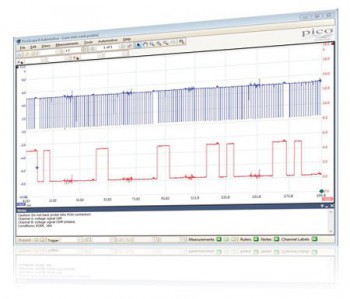
Software that grows with you
PicoScope has been designed to be easy to use for the beginner – the guided tests quickly get you up to speed and if you are confident using a multimeter and scan tool you will have no problem with a PicoScope.
PicoScope also has a depth of features that makes it the oscilloscope of choice for expert users ranging diagnostic specialists to designers of vehicle systems. For vehicle manufacturers, having dealers, field service technicians and designers all use the same tool has proved immensely valuable.
Some of the advanced features include:
- Serial decoding (CAN, LIN and FlexRay)
- Mask testing. Draw a mask around a known good waveform, the software then saves or alarms every time a waveform fails.
- Advanced maths. Plot changing frequency and duty cycle. Add filters. Add, subtract and perform complex equations between channels.
- Custom probes. Scale the output from linear and nonlinear sensors into real-world values.
In short we believe that PicoScope is the best automotive oscilloscope software for new and experienced users alike. But don’t just take our word for it: read some reviews from our users.
PicoScope 4225 and 4425 Series Specifications
This table lists the specifications that are most important to the average customer using the PicoScope for automotive diagnostics. If you have a more specific use for the product (or are just curious), detailed specifications are below this table.
| Key specifications at a glance | ||
|---|---|---|
| Model | PicoScope 4225 | PicoScope 4425 |
| Channels | 2 | 4 |
| Bandwidth | 20 MHz | |
| Resolution | 12 bits (16 bits enhanced) | |
| Sampling rate | 400 MS/s | |
| Buffer memory | 250 M samples | |
| Input ranges (full scale) | ±50 mV to ±200 V in 12 ranges | |
| Software supplied | PicoScope®, PicoDiagnostics® | |
| Language support | Chinese (simplified), Chinese (traditional), Czech, Danish, Dutch, English, Finnish, French, German, Greek, Hungarian, Italian, Japanese, Korean, Norwegian, Polish, Portuguese, Romanian, Russian, Spanish, Swedish, Turkish | |
| PC and power requirements | Desktop or laptop running Microsoft Windows XP (SP3), Vista, Windows 7 or Windows 8. Powered from PC USB port (USB 3.0 recommended, USB 2.0 compatible). |
|
Detailed specifications
Some of our customers use our automotive oscilloscopes for vehicle design and development and other non-diagnostic purposes. For these customers we have provided detailed technical specifications.
| Oscilloscope specifications (vertical) | ||
|---|---|---|
| Model | PicoScope 4225 | PicoScope 4425 |
| Bandwidth | 20 MHz (10 MHz on ±50 mV range) | |
| Channels | 2 | 4 |
| Vertical resolution | 12 bits | |
| Enhanced vertical resolution | 16 bits | |
| DC accuracy | ±1% of full scale | |
| Sensitivity | 10 mV/div to 40 V/div | |
| Input ranges (full scale) | ±50 mV to ±200 V in 12 ranges | |
| Input characteristics | 1 MΩ in parallel with 24 pF | |
| Input type | Floating, BNC connector | |
| Input common mode | 30 V | |
| Input coupling | Software selectable AC/DC | |
| Overvoltage protection | ±250 V (DC + AC peak) on single input | |
| Oscilloscope specifications (horizontal) | ||
|---|---|---|
| Maximum sampling rate 1 channel in use 2 channels in use 3 or 4 channels in use |
400 MS/s 200 MS/s 100 MS/s |
|
| Maximum sampling rate (USB streaming) | 20 MS/s (USB 3.0) 10 MS/s (USB 2.0) |
|
| Buffer memory | 250 M samples | |
| Waveform buffer | Up to 10,000 waveforms | |
| Timebase ranges | 100 ns/div to 5000 s/div | |
| Dynamic performance (typical) | |
|---|---|
| Crosstalk | 4000:1, DC to 20 MHz |
| Harmonic distortion | < −60 dB |
| SFDR | > 60 dB |
| Noise | 220 μV RMS on 50 mV range |
| Bandwidth flatness | DC to full bandwidth (+0.25 dB, −3 dB) |
| ADC ENOB | 10.8 bits |
| Triggers | ||
|---|---|---|
| Source | Any input channel | |
| Basic triggers | Auto, repeat, single, none | |
| Advanced triggers | Rising edge, falling edge, edge with hysteresis, pulse width, runt pulse, dropout, windowed | |
| Maximum pre-trigger delay | Up to 100% of capture length | |
| Maximum post-trigger delay | Up to 4 billion samples | |
| Spectrum analyzer | ||||||
|---|---|---|---|---|---|---|
| Frequency range | DC to 20 MHz | |||||
| Display modes | Magnitude, average, peak hold | |||||
| Windowing functions | Rectangular, Gaussian, triangular, Blackman, Blackman-Harris, Hamming, Hann, flat-top | |||||
| Number of FFT points | Selectable from 128 up to 1 million in powers of 2 | |||||
| Scale / units | X axis : linear or log 10 Y axis : logarithmic (dbV, dBu, dBm, arbitrary) or linear (volts) |
|||||
| Math channels | |
|---|---|
| General functions | −x, x+y, x−y, x*y, x/y, x^y, sqrt, exp, ln, log, abs, norm, sign, sin, cos, tan, arcsin, arccos, arctan, sinh, cosh, tanh, derivative, integral, delay |
| Filter functions | Low pass, high pass, band stop, band pass |
| Graphing functions | Frequency, duty cycle |
| Multi-waveform functions | Min, max, average, peak |
| Operands | Input channel, reference waveforms, time, constants, pi |
| Automatic measurements | |
|---|---|
| Scope mode | AC RMS, true RMS, cycle time, DC average, duty cycle, falling rate, fall time, frequency, high pulse width, low pulse width, maximum, minimum, peak to peak, rise time, rising rate. |
| Spectrum mode | Frequency at peak, amplitude at peak, average amplitude at peak, total power, THD %, THD dB, THD+N, SFDR, SINAD, SNR, IMD |
| Statistics | Minimum, maximum, average and standard deviation |
| Serial decoding | |||||
|---|---|---|---|---|---|
| Protocols | CAN, LIN, I²C, UART/RS-232, SPI, I²S, FlexRay | ||||
| Inputs | All input channels with any mixture of protocols | ||||
| Mask limit testing | |
|---|---|
| Mask generation | Auto generate from captured waveform, manual drawing, manual coordinate entry |
| Actions | Highlight on screen, select in buffer overview, activate alarm |
| Statistics | Pass/fail, failure count, total count |
| Alarms | |
|---|---|
| Initiating events | Capture, buffer full, mask fail |
| Alarm actions | Beep, play sound, stop/restart capture, run executable, save current buffer/all buffers, trigger signal generator |
| Data export | |
|---|---|
| Output file formats | BMP, CSV, GIF, JPG, MATLAB 4, PDF, PNG, PicoScope data, PicoScope settings, TXT |
| Output functions | Copy to clipboard, print |
| Environmental | |
|---|---|
| Operating environment Temperature range Humidity |
0 °C to 40 °C (15 °C to 30 °C for quoted accuracy) 5% to 80% RH, non-condensing |
| Storage environment Temperature range Humidity |
–20 to +60°C 5% to 95% RH, non–condensing |
| Physical dimensions | |
|---|---|
| Dimensions | 190 x 160 x 40 mm (approx 7.5 x 6.3 x 1.6 in) |
| Weight | < 900 g (approx 2 lb) |
| Software | ||
|---|---|---|
| Software included | PicoScope 6 oscilloscope software with waveform database and guided tests. PicoDiagnostics software | |
| Languages | Chinese (simplified), Chinese (traditional), Czech, Danish, Dutch, English, Finnish, French, German, Greek, Hungarian, Italian, Japanese, Korean*, Norwegian, Polish, Portuguese, Romanian, Russian, Spanish, Swedish, Turkish | |
For Korean software, please contact our Korean distributor VNP InterBiz
| General | ||||||
|---|---|---|---|---|---|---|
| Additional hardware (supplied) | USB cable, user manuals, software CD-ROM | |||||
| PC requirements | Microsoft Windows XP (SP3), Vista, Windows 7 or Windows 8. | |||||
| PC connectivity | SuperSpeed USB 3.0 (USB 2.0 compatible) | |||||
| Power requirements | Powered from USB ports | |||||
| Safety approvals | LVD compliant | |||||
| EMC approvals | Tested to meet EN61326-1:2006 and FCC Part 15 Subpart B | |||||
| Environmental approvals | RoHS and WEEE compliant | |||||
| Total satisfaction guarantee | In the event that this product does not fully meet your requirements you can return it for an exchange or refund. To claim, the product must be returned in good condition within 14 days. | |||||
| Warranty | 2 years | |||||
